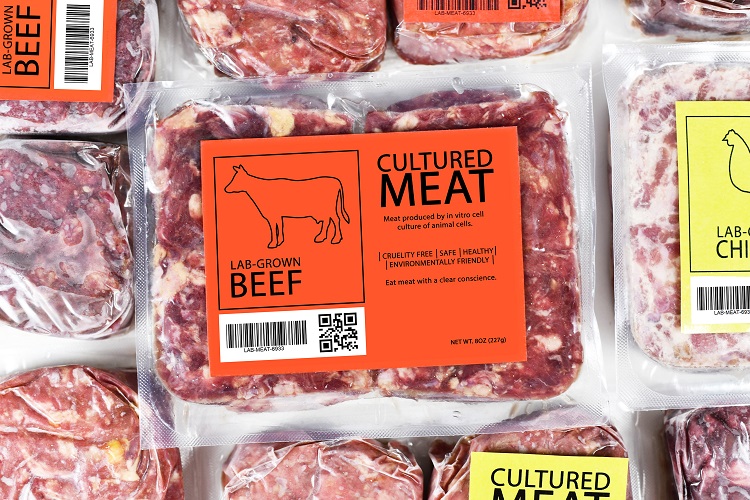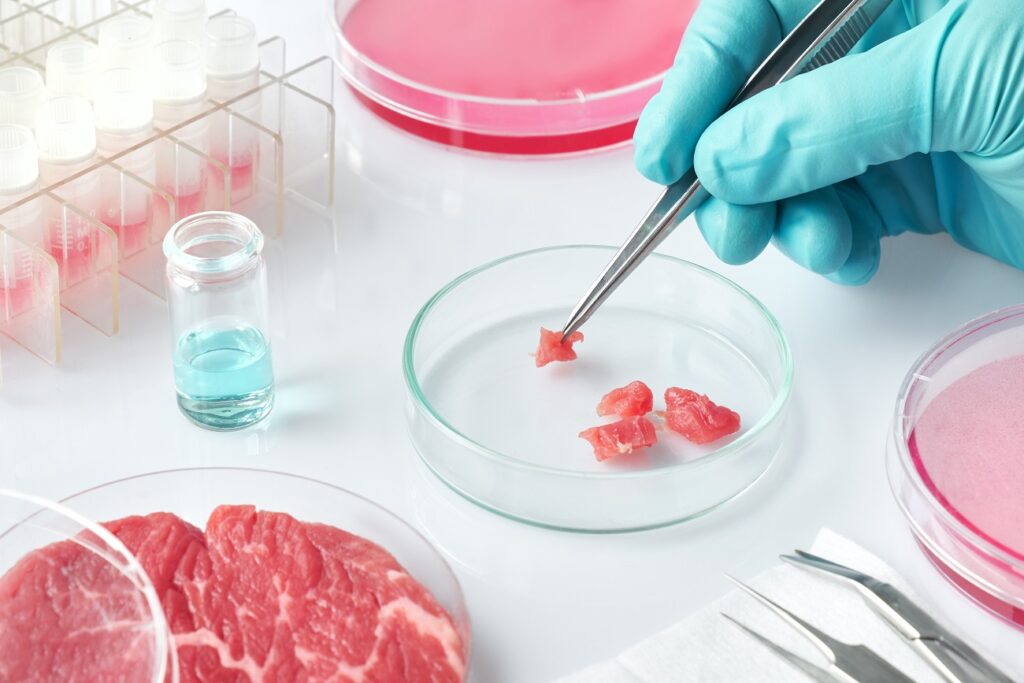Cultivated meat refers to genuine animal cells grown in a laboratory setting to produce a protein product similar to or identical to traditional meat. The field is relatively new, garnering international attention, praise, controversy, and skepticism. For this month’s edition of 18 Questions, we sit down with Sasha Howes, a process development engineer who enlightens us on the industry’s scientific, political, and ethical aspects.
- Please introduce yourself and your background.
I am a process development engineer for a start-up focused on creating beef products in a laboratory environment. I did biological process development engineering as my background. Before this, I was doing pharmaceutical development in the biological space. When this movement started, I decided to jump into this new field.
- What drove your career shift?
I have always been fascinated by agriculture and agricultural engineering. I wanted to be a biological engineer, and I was waiting for the cultivated meat field to come out of its true nascency before joining, ensuring I could make a difference in it with my skill set. I really believe in the statement and ethos of my company.
I grew up a meat-eater and became a vegetarian due to environmental objections. I like this field because it allows me to re-introduce meat to my diet ethically, if I choose to do so.
- What makes your company so unique?
I really like the diversity; all three of our co-founders are from different countries, and our CEO is a woman. The head of our Research & Development is also a woman. The value statements of my company are also stronger than other start-ups in the same space.
- What are the benefits of working in a female-driven company?
You don’t have to argue to be heard. This issue is becoming less of a problem, but it is still there, especially in larger companies where sexism has been built into the culture. Having a woman at the forefront ensures that equality is built into the culture from the beginning. For example, it influences healthcare alternatives, allowing workers to choose the option that best fits them.
Start-ups are best built when diversity is present at the outset. Building culture, communication, and benefits are integral to establishing any company.

- Explain the importance of scale in a start-up.
Start-up gains are a lot less concerned with whether the technology is viable, and more concerned with whether that technology can be scaled. To make money, you have to scale it.
In engineering, we have various “scale-up factors.” You can do many things in a petri dish or a lab setting and see success, but the actual mechanics of how cells interact in a larger (and more economical) environment is vastly different. We’re talking about going from making, at most, a gram of meat in a lab, to trying to supply hundreds of pounds per week or month, depending on how many people you are trying to feed.
The scale will also affect the price. There are different ways to release products onto the market, but the goal of my company is to reach price parity within six years.
- How are cultivated meat start-ups distributed nationwide?
North Carolina is a huge hub for biotech in general, and they are starting their own lab-based movement. Quite a few places are putting their pilot plants there, which is the second step after making a lab. Pilot plants test how to scale up. This development in North Carolina is partly because the land is cheap and because now the population can run those manufacturing facilities. But most start-ups are still on the West Coast.
- Why is the West Coast such a hub for start-ups?
People need to run the facilities. You either have to train an entire workforce, or you have to have an existing one. On the West Coast, people can move between companies without losing valuable time. Research Triangle Park in North Carolina and some European places are beginning to emulate this same culture.
- How is knowledge shared between cultivated meat start-ups?
It is still a new field, and we are building from the ground up. There is a balancing act; we want to share so that the industry can be successful, but we don’t like to share too much so that individual companies can be successful. Numbers are starting to be released; as people get more into manufacturing and less into the raw science, they are more willing to share some key process indicators (KPIs).
- Who are the stakeholders interested in facilitating laboratories and factories to produce cultivated meat?
Cultivated meat is international from the core. Some countries are more interested than others, of course. In those countries, regulatory approval takes a shorter amount of time. Some countries will even offer to help companies build facilities because they believe the industry will provide value to their people. In particular, Singapore and the Middle East are competitive players in the industry. Singapore has already approved its first product.
- Why is Singapore so ahead of the game?
Singapore wants to be more proactive because they are an island that has to import most of its food. They see cultivated meat as an economic and food security opportunity in a world already ravaged by climate change. We will have to find protein sources for a growing population. With cultivated meat, we could theoretically reclaim the land that has been taken for grazing. Cultivated meat can also be healthier, and in terms of lab-grown fish, it can remove microplastics, cadmium, mercury, and other chemicals currently being poured into the oceans.
- Describe your educational background.
I did a Bachelor of Science, and a Master of Science in biological systems engineering from a state school primarily focused on agriculture. This turned out to be a fascinating combination because I got the heavy-hitting chemical engineering alongside the biological elements and the lens of “this is what it looks like in agriculture.”
I went into my degrees hoping to work on biofuels, but as soon as I started college, the market tanked. But it was still a great program because I saw many things that hadn’t made it into the news yet, such as gene editing (which now helps make specific drugs). I spent time in the pharmaceutical industry before transitioning to cultivated meat, and much of the knowledge translates well.
- Did your education touch on the beef industry?
I did a lot of research on agriculture waste products, specifically from dairy farms. If you don’t treat the waste, it can harm rivers and bodies of water. But it can be collected, digested, and adapted into an agricultural waste product that is safer and more beneficial to use as fertilizer.
- What is the environmental footprint of cultivated meat compared to traditional meat?
Compared to beef, the environmental footprint of cultivated meat is massively less. Raising beef requires land, food, and water (for both the animal and its feed). It can destroy native landscapes for grazing. Traditional beef also demands waste processing, produces air pollution, and can be a nuisance to neighbors. Additionally, antibiotic genes, if hormone-treated, can escape into the environment and damage it.
On the other hand, we can vertically build cultivated meat facilities, taking up less space. Generally, it takes about 4-6 weeks to make 100 servings of cultivated meat, which is much faster than an animal, which takes years to grow!
- What is a day-in-the-life for you?
I do a lot of lab work, which I like. I conduct data analysis, crunch numbers, design experiments, and read published papers, and I also spend time in the lab “tinkering.” For instance, I spend a lot of time figuring out which environments fat and protein cells like by changing small things.
- Are some cells easier to work with than others?
It depends on how well we understand the basic biology of the cells. A pure muscle cell can be easier to work with, but fat can be more complicated. Where you source cells from also makes a difference. Some cells just don’t want to grow in a culture environment. Fish, for instance, is not as well understood because it is rarely used in the pharmaceutical industry. On the other hand, mammalian cells have been used more often in pharmaceuticals, so we better understand how they act.

- Describe the timeline of the cultivated meat industry.
UPSIDE Foods, which began working on cultivated chicken in 2015, is one of the first companies to obtain a functioning pilot plant in the United States (in California). Earlier this year, the FDA gave them a “no questions asked” letter, which does not mean that their product is approved, but that the FDA has no significant concerns. This is a major step for the industry. However, we still have the USDA body to go through. Getting approval in the United States can be challenging due to political and regulatory groups.
- Describe how lobbying has caused roadblocks.
There is a lot of beef lobbying. Texas has produced a bill that aims to prevent using the so-called cultivated beef, “beef,” because they want that term only to apply to cows grown up on a farm. These lobbyists include many people with a vested interest in the environmentally degrading and animal-harming methodologies of industrial agriculture.
- What ethical pros and cons are at play?
As my boss says, “take cells away from an animal, and it walks away slightly irritated, but it still walks away!” You can go back to that same animal and get more cells, or (as our goal is) you may never need to take a living organism’s cells again. We hope cultivated meat companies can produce steak, pork cutlets, or bacon with the same cells.
“What constitutes life?” is a big question. For instance, is cultivated meat vegan? Some cultures and religions are also concerned with the concepts of halal and kosher. If animals have not been slaughtered, can cultivated meat be halal or kosher? For some Native Americans, the method of slaughter forges a connection with the animal’s spirit, but without cultivated meat, can that connection be created? Do we lose some of the value of that protein sacrifice?
Also, GMOs can be tricky. Does cultivated meat constitute a GMO? We can add or change genes to make manufacturing easier or to improve nutritional quality, but consumers may not feel comfortable with that.
Aside from ethics, some people do not trust cultivated meat because of the “yucky” factor. Americans do not trust larger manufacturers, and thinking about meat stored in steel containers and in large warehouses can be alien at first. But I think this mindset is slowly changing.
 Food
Food Farmers
Farmers Sustainable Living
Sustainable Living Living Planet
Living Planet News
News